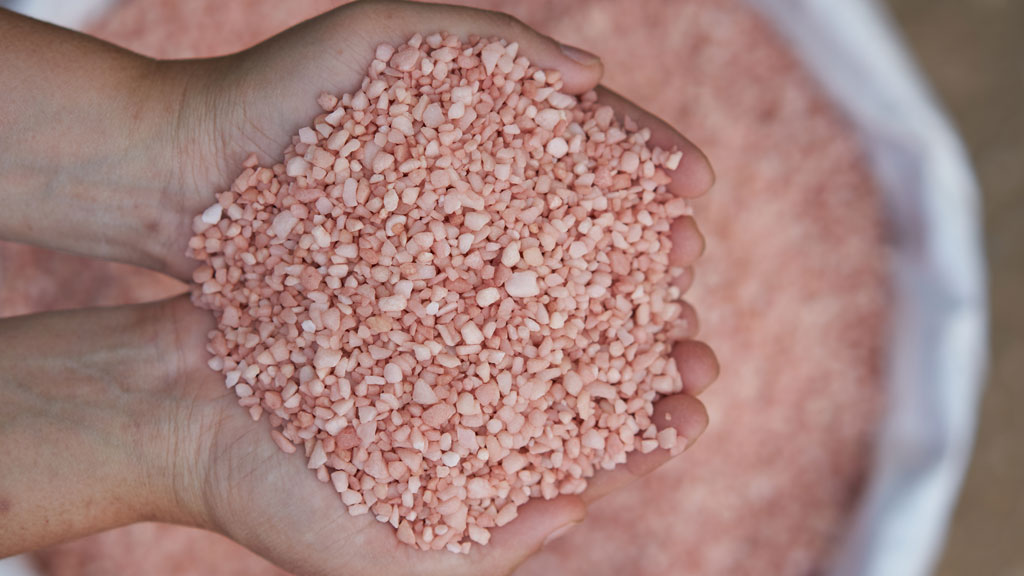Manitoba’s first potash mining operation has set up shop near the community of Russell and is getting ready to begin production, setting the stage for the province to become a global leader in mineral development.
“We have to finish wiring the building, putting the rest of the equipment in place and then we’ll connect the two wells, the input and the extraction well to start our facility,” says Daymon Guillas, president, of Potash and Agri-Development Corporation of Manitoba (PADCOM). “I think it is very positive for Manitoba.”
The mine will produce 50,000 to 100,000 tonnes of potash a year.
Last December, the project team confirmed a potash seam and then drilled two horizontal wells under the ground. In June, another team connected the wells to form a loop for potash extraction. A 10,000-square-foot building was constructed that will house cooling tanks, dewatering equipment, dryers and conveyor belts and storage.
The physical footprint of the actual potash operation will be small and the company intends to use a more environmentally friendly mining process, along with power from Manitoba Hydro which is a low CO2-emitting energy source.
Technology used by the operation will result in less carbon production and water use. Potash operations typically create 600 to 2,000 pounds of carbon per tonne of potash and 600 to 2,000 gallons of fresh water per tonne. PADCOM figures it will produce 36 ounces of carbon and use 132 gallons of water per tonne.
Alex Christopher, president of the Prospectors and Developers Association of Canada (PDAC), says the project is a big deal for Manitoba and opens the door to other potash mining developments in the province.
“It is great to see this project get approval as growth in responsible exploration and mining is positive for economic and social prosperity across Canada. With the PADCOM project advancing to production, Manitoba is showing how industry and Indigenous collaboration works to advance investment in mining in the province.”
The company has partnered with Gambler First Nation on the venture.
The province has a longstanding record of base and precious metal production and the region could be a major supplier of the minerals required for the transition to low carbon technologies, says Christopher.
“Manitoba has incredible mineral wealth and potential for exploration and development, which presents major social and economic opportunities. Over the last 100 years, Manitoba has developed over 70 mines and accounts for 37 per cent of Canada’s zinc output. It generates more than $56 million in exploration expenditures annually, while employing more than 10,000 people.”
Copper, nickel, zinc and gold are the primary minerals mined in Manitoba over the years.
Christopher says there is a real opportunity, not just for Manitoba but for Canada as a whole, to benefit from the growth in demand for critical minerals inherently linked to the world’s transition to a low-carbon future.
Potash operations in Ontario employ 151,000 people and generate $569 million in exploration expenditures. Saskatchewan employs more than 18,000 people and attracts $159 million in expenditures.
“We are seeing an overall all-time high in Canadian exploration for traditional minerals, such as gold, copper, nickel and an increase in exploration for less-traditional critical minerals that are essential for the low-carbon transition, such as cobalt, lithium and graphite,” he explains.
Federal and provincial fiscal incentives, such as flow-through shares, the Mineral Exploration Tax Credit and announcement of the new Critical Mineral Exploration Tax Credit have most certainly attributed to the influx, says Christopher.
“It is an exciting time to be in the industry, particularly for young people just joining, as I see real opportunity over the next several decades to attract new talent to the industry as we expand our critical mineral supply chains and continue adopting innovative techniques and technologies.”
According to Guillas, the potash mining industry struggled to get off the ground for a decade or two, but is now taking off in Manitoba because of the leadership shown by the provincial government and Premier Heather Stefanson in bringing the Manitoba Metis Federation and First Nations groups to the table.
“I think mining in Manitoba will only go upwards quickly because of the steps they’re taking by involving all players in advance in a meaningful way, and not a token way.”
PADCOM plans to ramp up production and has an eye on expansion.
“Once we have this up and running and know what we’re doing and have our feet wet, we will continue to ramp up and find markets,” he says. “We’re starting at 50,000 or 100,000 tonnes and we’ll grow to 200, 250, so like every industrial business we’ll spend a couple of million dollars a year on growing the company.”
PADCOM is locally-owned, a source of pride for those working at the company.
“All the shareholders are from Manitoba so we’re very fortunate to be able to do that,” says Guillas. “We’re not owned by a pension fund or out-of-country people, so all of the wealth stays on the Prairies.”







Recent Comments
comments for this post are closed